(c) Copyright 2007, Kenneth R. Conklin, Ph.D. All rights reserved
On Friday June 8, 2007 a group of ethnic Hawaiian organizations and individuals staged a protest against the Grassroot Institute of Hawaii in front of the building where its office is located. The event had the outward appearance of a 1960s-era street demonstration by "little people" using guerilla street-theatre tactics (prayer and folk songs) to protest at the headquarters of a powerful corporation or government agency.
But in fact it was a form of intimidation by a group of extremely wealthy and powerful race-based institutions complaining that a small local think-tank dares to challenge their "right" to exercise racial exclusion and their demand to expand their already-existing racial supremacy by establishing a race-based government.
The event was also interesting because it clearly showed the active cooperation of major institutions seeking passage of the Akaka bill, assembling under the leadership of Hawaiian secessionists demanding that the 50th star be ripped off the American flag. The institutions seeking passage of the Akaka bill, present at this event, often claim that the bill would not foster secession. Many secessionists, including some present at this event, protest against the Akaka bill because they think it would interfere with eventual secession. Yet this event brought all of them together in solidarity to protect an Evil Empire against think-tank thoughts that challenge its belief-system and lawsuits intended to dismantle it.
The Evil Empire is described in a 302-page book published March 1, 2007 entitled "Hawaiian Apartheid -- Racial Separatism and Ethnic Nationalism in the Aloha State." The cover shows an American flag with its 50th star ripped off, and the Great Seal of the State of Hawaii broken apart. The cover, detailed table of contents, and entire Chapter 1 ("The Gathering Storm") are available for free at
http://tinyurl.com/2a9fqa
The $8-15 Billion Kamehameha Schools was one of the "protesters." It was represented on the sidewalk by its highly-paid CEO Ms. Dee Jay Mailer and its highly-paid media spokesperson Ms. Ann Botticelli. For proof of the presence of CEO Mailer, and her short speech at the event, see transcript of TV news broadcast and photos, below. Kamehameha enjoys an enormous tax exemption as a charitable trust. Federal law imposes severe limits on political activity by tax-exempt charitable trusts as a condition for retaining tax-exempt status; but somehow Kamehameha Schools (Bishop Estate) has always played a major role in politics both in Hawaii and nationwide. See Samuel P. King and Randall W. Roth, "Broken trust: greed, mismanagement & political manipulation at America’s largest charitable trust" (Honolulu: University of Hawaii Press, 2006). A large website providing background information and documentation is at
http://brokentrustbook.com/
The Office of Hawaiian Affairs sent staff from its monthly newspaper so that a report could be included in the July edition (however, the July edition turned out not to mention this incident). Alu Like sent representatives. Alu Like recently celebrated its 30th anniversary as the first federally funded racially exclusionary Hawaiian institution after the Hawaiian Homes Commission Act of 1921; its original purpose was to provide vocational training for ethnic Hawaiians but in recent years it has expanded to other areas including a Native Hawaiian library and an internet archive of Hawaiian-language newspapers from the Kingdom and Territorial periods.
The madrassa-like University of Hawaii Center for Hawaiian Studies was represented by its highly-paid chairman, Professor Jonathan Osorio. Mr. Osorio is also a professional entertainer who gives night-club performances singing Hawaiian-language songs while accompanying himself on his guitar; and he also is a paid consultant and lecturer in the tourist industry. At this "protest" event he led the singing of "Kaulana Na Pua," a song composed in January 1893 to protest the revolution that overthrew the Hawaiian monarchy and to pledge support to ex-queen Liliuokalani (an armed counter-revolution was attempted in January 1895 led by racist firebrand Robert Wilcox). Today's sovereignty activists use this song both as a bitter reminder of past "injustice" and a rallying cry for restoration of Hawaii as an independent nation.
The Democratic Party of Hawaii gave permission for the "protesters" to use its printing equipment to print various materials, including flyers. This fact illustrates the political connectedness of the protesting institutions and individuals -- they could easily have used other facilities, but it seemed perfectly natural and ordinary for them to seek and receive such a favor from the most powerful political party in the history of Hawaii.
Some of the protesters entered the building where GRIH has its office, and distributed notices to all the other tenants in the building informing them of the reason for the protest. The notices also may have had the effect of disrupting the activities of those other tenants and perhaps causing them to suggest to building management that it might be wise to ask GRIH to move out for fear of similar incidents in the future. The people leading the protest have many long years of experience as environmental and anti-military protesters and as political strategists, so it would not be unreasonable to suppose that they intended to cause trouble with the neighbors. The protest leaders also have previous experience taking over and occupying administrative offices, including the President's Office at the University of Hawaii.
Ikaika Hussey, leader of this event, was a student activist at the University of Hawaii and a writer for the student newspaper. He was elected as a delegate to the State of Hawaii government-funded Native Hawaiian Convention whose stated purpose was to develop one or more proposals for race-based political sovereignty. The convention had two factions, with a minority favoring the model of a nation-within-a-nation (Akaka bill) and a majority favoring independence. Hussey became the public spokesman for the independence faction, which was the only faction left standing by the time the convention faded away due to lack of additional government funding. In 2000 Hussey ran as a Democrat for the state House of Representatives (taking a candidate's oath to support and defend the Constitution of the United States despite his clear intention of violating it). Two e-mails from Hussey are copied below, one calling for people to participate in the protest of June 8 and the other reporting on what happened.
Also present at the protest was Dr. Kekuni Blaisdell, a medical doctor and professor emeritus at the University of Hawaii School of Medicine. Interestingly for someone who advocates blood-nationalism, his medical specialty is the study of blood diseases. Blaisdell is the godfather of the Hawaiian independence movement. He has attended numerous international conferences, especially in Pacific island venues, pressing foreign diplomats to support Hawaiian independence. Also present was Blaisdell's long-time friend and colleague in the independence movement, Lynette Cruz. Cruz has a Ph.D. and is a professor of anthropology at Hawaii Pacific University. Her dissertation was on the history of the sovereignty movement; and she is extremely active in running many sovereignty rallies, organizations, and TV programs.
It seems strange that no newspapers and only one TV station reported on the June 8 event, although all were presumably invited by these very experienced media-savvy protesters. TV station KGMB had a crew at the event. It broadcast a very short report about the protest on both the 6PM and 10PM news on June 8, including footage of Kamehameha CEO Dee Jay Mailer standing with protesters and expressing a sentence or two in support (see transcript and photos below); but the station's website has no record of news about the event having been broadcast. Perhaps the "establishment" institutions like Kamehameha School, OHA, etc. decided it might cause trouble for the Akaka bill if they were seen publicly working in concert with the secessionists. Of course the event was videotaped by secessionist activists using equipment from the public access cable TV system "'Olelo", so eventually there might be a program on cable TV.
The immediate excuse for the "protest" was an e-mail that had been sent a couple weeks previously from attorney David Rosen to two friends, one of whom was GRIH chair Richard Rowland, asking whether Rowland was aware of any potential clients for a new lawsuit Rosen was planning against Kamehameha Schools' admissions policy. That e-mail was forwarded by Rowland to some of his friends, and found its way to a large number of Kamehameha alumni and Hawaiian activists who were angry and outraged that another lawsuit was apparently getting started. Kamehameha had just settled a similar lawsuit at the last possible moment while the Supreme Court Justices were considering whether to accept the lawsuit for a review of the 9th Circuit Court's 8-7 decision upholding the admissions policy. The "Hawaiian community" had breathed a sigh of relief that its racially exclusionary policies had survived the latest legal challenge, and now they were once again faced with the possibility of another challenge.
Haunani Apoliona, Chair of the Office of Hawaiian Affairs, had used three consecutive editorials in the OHA monthly newspapers of August, September, and October 2006 to attack what she called "The Nutgrass Conspiracy." The title of her trilogy was a clear reference to the Grassroot Institute, which she named in her editorials as a leader of a vast rightwing conspiracy (reminiscent of Hillary Clinton's famous diatribe) against Native Hawaiian "rights." Another OHA trustee also editorialized against GRIH. The OHA trustees had demonized GRIH in their newspaper with a circulation of 60,000. So now, when the e-mail addressed to the head of GRIH was sent to hundreds (perhaps thousands) of Hawaiian activists, the stage was set for dramatic action. See "Nutgrass Network Conspiracy -- OHA trustees put forward a conspiracy theory to attack civil rights activists who dare to oppose their nutty, racist agenda" at:
https://www.angelfire.com/planet/bigfiles40/ohanutgrassconspiracy.html
On June 27, 2007 the leftist "alternative" newspaper "Honolulu Weekly" published an article by Travis Quezon which included the previously unreported fact that the "host culture" public charter school "Halau Ku Mana" had sent students to participate in the June 8 protest. Travis Quezon’s slanted story about the June 8 protest against Grassroot Institute of Hawai‘i portrayed a David vs. Goliath situation, with the kids from Halau Ku Mana Charter School as David and the GRIH as Goliath. But Quezon got it backwards. On January 25 Star-Bulletin reported the $8 Billion Kamehameha Schools granted $4.8 Million to Halau Ku Mana and 11 other "public" charter schools. In June kids from HKM showed up to protest against GRIH over the appearance that the head of GRIH might refer an attorney to potential plaintiffs for a civil rights lawsuit against Kamehameha's racist admissions policy. Highly paid Kamehameha CEO Dee Jay Mailer gave a speech at the protest, standing next to an "Official Use Only" van. See photos below. Duh! Connect the dots. So who is David and who is Goliath? Why are kids from a taxpayer-funded public charter school being used on a Friday morning as pawns in behemoth Kamehameha's political power play to stifle free speech by a small think-tank that dares to question Kamehameha's racist policy?
Below are the following items:
1. E-mail from secessionist Ikaika Hussey on June 7, 2007 mobilizing the anti-GRIH event of June 8.
2. E-mail from Ikaika Hussey reporting after the event, describing what happened and including contents of the flyer.
3. Transcript of news report broadcast on KGMB9 TV 6 PM Friday June 8. (See also photos captured from the news broadcast, near the bottom of this webpage)
4. Commentary by Jere Krischel, Senior Fellow of GRIH, posted on a GRIH blog on June 10.
5. "Takin' It to the Streets" Commentary by Brandon Bosworth, director of publications at GRIH, posted on a GRIH blog on June 13.
6. Brief comments "Thanks to the SS Corps" by GRIH head Dick Rowland, posted on a GRIH blog on June 13.
7. Link to webpage containing the 4 editorials by two OHA trustees in the OHA monthly newspapers of August, September, and October 2006 attacking "The Nutgrass Conspiracy."
8. Link to webpage explaining how the Akaka bill would empower the secessionist movement. The webpage provides proof that some important long-time secessionist leaders favor the Akaka bill, and that Senator Akaka himself strongly hints that he also favors secession as a long-term goal and clearly states that the bill would not interfere with secession.
9. Link to webpage explaining important attitudes, beliefs, and goals shared by both the Akaka bill supporters and the secessionists.
10. Link to webpage describing terrorist-like disruption of Statehood Day celebration in August, 2006 led by some of the same protesters who were present on June 8, 2007 including Kekuni Blaisdell, Lynette Cruz, and Ikaika Hussey.
11. Newspaper report describing the e-mail from attorney David Rosen to GRIH head Richard Rowland asking whether Rowland might know of any potential plaintiffs for a new lawsuit against Kamehameha.
12. Photos captured from recording of KGMB9 TV news broadcast June 8, 6 PM.
13. Photos taken by protesters to showcase their protest of June 8, 2007 at the GRIH office.
---------------------
1. E-mail from secessionist Ikaika Hussey on June 7, 2007 mobilizing the anti-GRIH event of June 8. This e-mail was posted on the Hawaiian Kingdom Info blog maintained by Scott Crawford. The statement of purpose on the masthead of this blog says "This Blog is about Hawaii's status as an independent country under prolonged illegal occupation by the United States, and the history, culture, law & politics of the islands."
http://www.hawaiiankingdom.info/C1295638618/E20070607190922/index.html
Teach-in @ Grassroot Institute
Rec'd via email...
From: "ikaikahussey" <ihussey @ hawaii.edu>
Date: Thu, 07 Jun 2007 21:26:19 -0000
Subject: Teach-in @ Grassroot Institute:: Friday 10 am - 1 pm
Aloha aina ia kakou pakahi a pau:
Since Rice v. Cayetano, the Grassroot Institute has played a key role in the legal attacks on the heritage of the Hawaiian nation. Recently they have been helping to instigate a new lawsuit against the Kamehameha Schools. It's time for us to defend our heritage, and demand an end to these immoral and indefensible actions. Let's come together from our many perspectives, organizations, and backgrounds to form a united front against the extreme-right conservatism of the Grassroot Institute.
Teach-In this Friday 10 am - 1 pm!
Outside the offices of the Grassroot Institute, with signholding on the public sidewalk
1314 South King St (Interstate Building, intersection of Keeaumoku and King St.)
Parking available on Young Street
Featuring speakers from:
- The Kamehameha Schools (tentative)
- The Hawaiian Charter Schools
- the Independence Movement
- Kamakakuokalani Center for Hawaiian Studies
- the Office of Hawaiian Affairs (tentative)
- the Native Hawaiian Bar Association (tentative)
- and the many allies of the Hawaiian people
Please come to hold signs, to learn about the central role of the Grassroot Institute in the attacks on Hawaiian heritage, and to build unity.
Questions? Email Ikaika Hussey at ihussey @ hawaii.edu.
Posted: Thu - June 7, 2007 at 07:09 PM Hawaiian Independence Blog
-------------------
2. E-mail from Ikaika Hussey reporting after the event, describing what happened and including contents of the flyer. This e-mail was posted on the Hawaiian Kingdom Info blog maintained by Scott Crawford. The statement of purpose on the masthead of this blog says "This Blog is about Hawaii's status as an independent country under prolonged illegal occupation by the United States, and the history, culture, law & politics of the islands."
http://www.hawaiiankingdom.info/C1295638618/E20070609172720/index.html
REPORT ON ANTI-GRASSROOT INSTITUTE DIRECT ACTION
Rec'd via email
From: Ikaika Hussey <ikaika @ husseyassociates.com>
Date: Fri, 8 Jun 2007 15:05:51 -1000
Subject: Report on anti-Grassroot direct action
Aloha Aina Kakou:
Mahalo to everyone for coming out today at such short notice for the action against the Grassroot Institute. Mahalo to Dee Jay Mailer and Ann Botticelli of KS, the haumana and kumu of the Hawaiian charter schools, Mervina Cash-Kaeo of Alu LIke, Jon Osorio of CHS, Uncle Kekuni Blaisdell, and our taroroots activists --- Uncle George Kahumoku Flores, Ben manuel, Lynette and James, and Regina Gregory and her daughter. And mahalo to Adrian Kamalii for the mea 'ai, and to the Democratic Party for allowing us to use their photocopy machine.
We started to show up shortly after 10 am. The actual action began at 10:30, when the students arrived. We opened with pule, and a lively rendition of Kaulana Na Pua, led by Jon Osorio. We discussed the parameters for the action, and the ground rules (no harm to businesses, focus only on GR Institute, abide by landlord's directives). Jon Osorio gave a great speech, congratulating the spirit of resistance, followed by Dee Jay Mailer's invocation that we were there to protect the inheritance left to us by our alii. She said that this kind of action isn't foreign to Kamehameha Schools, and that "it's just right." We couldn't agree more.
After the opening, the students and adults took the sidewalk with small handheld signs. The students performed powerful chants. Visually, it was a stirring sight --- bright t-shirts, majestic Hawaiian flags, and clear voices. We distributed an open letter to the tenants of the Interstate Building to inform passers-by about why we were there (enclosed below).
At about 11:30, a delegation of about 12 students and teachers went upstairs to speak with the Grassroot staff, and ask them to explain why they are attacking our rights. A student informs us that just as we were getting to their office floor, he saw someone quickly leave the office with a stack of boxes. By the time the delegation got to the office, it was completely vacated.
Jon Osorio made the excellent point that we (the lahui Hawaii) move in the open, in the light of the day, without fear or shame, while the Grassroot types move in the shadows, as if they are ashamed and afraid of confrontation. We should be proud of our wiwo'ole -- our fearlessness -- in our willingness to take action publicly.
We closed the event at about noon with pule and oli mahalo.
Reporters from Ka Wai Ola o OHA, KGMB, the Honolulu Weekly, and Olelo were there to document our action and our leo.
Several major organs of our Hawaiian nation are working now as a coalition to develop a strategy to protect against the lawsuits. The unity being built is impressive. Unfortunately, because of schedule difficulties, more organizations couldn't be with us today. Hopefully more people will be able to participate next time.
Aloha aina,
Ikaika
Flyer handed to building tenants in the extended entry...
Update: Lynette has some photos from the protest.
Tenants of the Interstate Building
1314 South King St.
Honolulu, HI 96814
June 8, 2007
Aloha Tenants of the Interstate Building:
This morning, members of the Hawaiian community are gathering outside your workplaces for a single purpose: to shine a light on an organization housed here that is working to undermine and erode Native Hawaiian rights. That organization is the Grassroot Institute, located in Suite 1163. The Grassroot Institute, both corporately and via its members and affiliates, is part of a reactionary movement to expropriate the collective inheritance of the indigneous peoples of Hawaii. In so doing, they have misused the grand language of the U.S. civil rights movement to facilitate their goals, while continuing the deplorable tradition of the jingoists, the yellow journalists, and the annexationists of the 19th century.
On May 15, 2007, attorney David Rosen sent an e-mail entitled "Request for Plaintiffs" to two individuals, Richard Rowland of the Grassroot Institute, and attorney William Burgess. Mr. Rosen explained in the e-mail that he intended to file a new lawsuit challenging Kamehameha Schools’ admission policy, only days after a settlement in Doe v. Kamehameha Schools was announced to the public. Mr. Rowland accepted Mr. Rosen’s request for assistance and forwarded the e-mail to an unknown number of recipients.
Mr. Rosen is a mere attorney – but it is the Grassroot Institute that serves as cheerleader, organizer, and think tank for the dissolution of indigneous rights.
And the Grassroot Institute does not operate alone: it is a local node in an ultraconservative sweep throughout the United States which aims to dismantle women’s rights, minority rights, LGBT rights, ecological sustainability, international cooperation, and supports for working families.
It’s our sincere hope that our presence here today does not hinder your daily business. Our intent is to educate the general public, and to defend our heritage. Thank you for your patience.
Aloha Aina
The People On the Sidewalk
Posted: Sat - June 9, 2007 at 05:27 PM Hawaiian Independence Blog
** Ken Conklin's note on language: "Aloha 'Aina" salutation and also signoff superficially means "love for the land" but nowadays it is also being used to mean "patriotism" in the sense of "we are the patriots who love our land [nation of Hawai'i]"
---------------
3. Transcript of news report broadcast on KGMB9 TV 6 PM Friday June 8. (See also photos captured from the news broadcast, near the bottom of this webpage)
KGMB-9 6 pm news
Keahi Tucker – KGMB-9 6:00 pm news anchor:
“A group of Kamehameha students and Hawaiian activists staged a rally today, protesting some recent lawsuits against Hawaiian policies and traditions
About 50 people marched outside the Grassroots Institute which has been battling Kamehameha’s admissions policy giving preference to native Hawaiians.
The protestors had some questions for any lawyers planning to sue”
Dee Jay Mailer:
“What is it about us as a people that is so threatening that they would want to do that? What is it? So, so we’re here because we’re used to standing and fighting the battle repeatedly.”
Keahi Tucker:
“The rally got some occasional honks of support from passing drivers but it turns out the Grassroots Institute was closed today.”
********* end
(See also photos captured from the news broadcast, near the bottom of this webpage)
---------------
4. Commentary by Jere Krischel, Senior Fellow of GRIH, posted on the GRIH blog.
http://historymystery.grassrootinstitute.org/2007/06/10/the-people-on-the-sidewalk/
On June 8th, 2007, a motley group of native Hawaiian supremacists, radical sovereignty activists, Kamehameha Schools representatives and unfortunately indoctrinated students made a protest at the Interstate Building at 1314 South King Street. They were protesting the civil rights activism and educational activities of the Grassroot Institute of Hawaii, making the bold and unfounded claim that, "The Grassroot Institute, both corporately and via its members and affiliates, is part of a reactionary movement to expropriate the collective inheritance of the indigneous peoples of Hawaii."
They further went on to claim that the Grassroot Institute of Hawaii engaged in "the deplorable tradition of the jingoists", while themselves stating with no hint of recognizing their own hyperbole that the Grassroot Institute of Hawaii "aims to dismantle women’s rights, minority rights, LGBT rights, ecological sustainability, international cooperation, and supports for working families." It is surprising that they did not also blame the Grassroot Institute of Hawaii for global warming, hurricane Katrina, the war in Iraq, AIDS, cancer and the sexual abuse of parishioners by Catholic priests.
And why such venom for a local think tank? Their apparent trigger was the forwarding of a request for plaintiffs by David Rosen, who hopes to continue the civil rights struggle that was temporarily stalled by the large cash settlement presumably paid to John Doe by Kamehameha Schools to end the appeal to the Supreme Court regarding the racially discriminatory admissions policies of Kamehameha Schools.
"The People On The Sidewalk" stated that the Grassroot Institute of Hawaii has "misused the grand language of the U.S. civil rights movement to facilitate their goals." Apparently, the grand language of the U.S. civil rights movement is not allowed to include the preservation of equal rights for all people, regardless of race or ancestry. These native Hawaiian victimhood industry specialists cannot see the plain racism they practice, and cannot perceive the evil and wrong they do to the memories of their kupuna and our collective heritage as Hawaiians of all races and backgrounds. The Kingdom of Hawaii was founded through the cooperation of Kamehameha the Great, and John Young of Britain. The first constitution of the Kingdom of Hawaii declared all people were "of one blood". The Kingdom of Hawaii never had any special privileges associated with race. But somehow, the native Hawaiian victimhood industry is hell bent on undoing the civil rights embraced by our ancestors, by our kingdom, by our state and by our country.
There is no "collective inheritance" to people of any specific "race" anywhere on this planet - we are all humans, and dividing us by arbitrary lines is the bane of racism exposed. The Nazis did not have any collective racial claim to supremacy in Europe during WWII, the white South Africans did not have any collective racial claim to supremacy during the era of apartheid, and neither do people with the smallest fraction of ancestry traced back to pre-1778 immigrants to Hawaii have any just claim against their own peers, neighbors and cousins.
I have one question for "The People On The Sidewalk" - where would you send other people not of the proper race to go to collect their "collective inheritance"?
Some seem to prefer a Hawaii that harbors exclusive rights for people of the proper racial background - the Grassroot Institute of Hawaii, on the other hand, believes in equality and aloha for all. Apparently, such dedication to civil rights is worthy of protest by the rich and powerful leaders of the native Hawaiian victimhood industry - Auwe!
(Jere Krischel is a Senior Fellow with the Grassroot Institute of Hawaii, born and raised in Hawaii and currently living in California with his wife and two young children.)
-----------------
5. "Takin' It to the Streets" Commentary by Brandon Bosworth, director of publications at GRIH, posted on a GRIH blog on June 13.
http://www.grassrootinstitute.org/GrassrootPerspective/TakinToStreets.shtml
Takin' It to the Streets
By Brandon Bosworth
June 13, 2007
I wonder sometime what protesters hope to accomplish. They certainly aren’t trying to engage in debate. Walking around carrying signs and making speeches is not a very effective form of discourse. Do they actually suppose they are going to change people’s minds about issues? If so, the protesters are divorced from reality. Can you imagine a stalwart Republican driving past a ‘Not in Our Name’ rally and thinking, “Gee, that person with all the piercings is holding a sign saying Bush=Hitler. Maybe I should reconsider my politics.” Or a businessman strolling past an anti-globalization mob and saying, “Wow, look at all those hammer-and-sickle banners. Maybe I should forget the whole capitalism thing.”
These thoughts were on my mind when I learned a small mob of Native Hawaiian racialist decided to picket the building hosting the Grassroot Institute of Hawaii offices. They chose to target us because they don’t like some of the things we believe in, such as racial equality. How dare we question Kamehameha Schools discriminatory entrance policies! Makes me wonder where free-speech and civil rights would fit in to a “Reestablished Hawaiian Kingdom.”
Ikaika Hussey helped organize the little brouhaha. His report on the “anti-Grassroot direct action”--posted at the Hawaiian nationalist site www.hawaiiankingdom.info--was pretty self-congratulatory, thanking all the “taroroots activists” (haha... who said lefties don’t have a sense of humor?), and, interestingly, “the Democratic Party for allowing us to use their photocopy machine.”
According to Hussey, “a delegation of about 12 students and teachers went upstairs to speak with the Grassroot staff, and ask them to explain why they are attacking our rights.” Sending a mob to an organization’s office, uninvited and without permission, seems the height of rudeness and inconsideration. Of course, milling about in front of a place of business on a public sidewalk for a few hours seems pretty damn rude as well, but since when have leftists been known for their manners or consideration of others?
The “delegation” was apparently offended that those at the GRIH didn’t drop everything to accommodate them. Hussey wrote, “Jon Osorio made the excellent point that we (the lahui Hawaii) move in the open, in the light of the day, without fear or shame, while the Grassroot types move in the shadows, as if they are ashamed and afraid of confrontation. We should be proud of our wiwo'ole -- our fearlessness -- in our willingness to take action publicly.”
I am unsure how an organization like GRIH that has a website, offices, engages with the public, has a weekly newsletter, etc., “moves in the shadows.” Nor are we “afraid of confrontation.” We welcome true debate, and you can’t have a true debate with a mob.
Hussey’s line about his ilk's “willingness to take action publicly” is very telling. Many radical groups realize deep-down that they can’t win the public debate through facts, argument, debate, and other forms of rational, civilized discourse. Since they can win through reason, they hope to win by emotion. By ‘takin’ it to the streets’ they are basically saying, “Look how much we care about this... how strong our feelings are!” Passion, they hope will trump everything.
Maybe. But maybe not. Historians are coming to question the commonly held notion that the protests against the Vietnam War helped end the conflict. More likely, public disgust at the protester’s antics probably prolonged America’s involvement in Vietnam. Sixties radicals may have very well aided in advancing the cause they so opposed.
In light of this, let’s hope Ikaika Hussey, Jon Osorio, and others hold regular demonstrations and protests in favor of the racialist policies they hold dear.
Brandon Bosworth is Director of Publications at GRIH.
-----------------
6. Brief comments "Thanks to the SS Corps" by GRIH head Dick Rowland, posted on a GRIH blog on June 13.
http://www.grassrootinstitute.org/GrassInReview/GrassInReview06-12-07.shtml
WEEKLY GRASS IN REVIEW -- June 13, 2007
Thanks to the SS Corps
A Message from Dick Rowland
On Friday, June 6, Hawaii's own SS (Speech Suppression) Corps picketed the King Street building housing our office. It seems they have decided they are not comfortable with our calls for more public debate and discussion regarding discrimination for or against individuals based on the accident of race or ancestry instead of that earned and displayed through character or merit.
Apparently they want to shut us up. Never mind that Native Hawaiian entitlements issues are contentious in our U.S. courts, government, and press. They want to muzzle us. Further, they tap government money to fund their endeavors. The call for the gathering came from the University of Hawaii e-mail system. The Office of Hawaiian Affairs, also a state agency, makes a habit of attacking us using government funds. They travel to Washington D.C. to lobby on your dime. The Governor does as well.
Now it occurs to us: Why don't we have a demonstration to shut them up? Nope. We favor free speech, we want debate. We want public education on this issue. The more the public knows, the less enthusiasm there is for race-based prejudice.
So, we thank the picketers for the publicity. It fits our agenda.
Martin Luther King said it best in his famous speech given in Washington, D.C. on August 28, 1963:
“I have a dream that my four little children will one day live in a nation where they will not be judged by the color of their skin but by the content of their character.”
If you want to see the anonymous thoughts of the picketers, as expressed in a letter to all occupants of our office building please click here. [see item #2 above]
-----------------
7. A webpage contains the 4 editorials by two OHA trustees in the OHA monthly newspapers of August, September, and October 2006 attacking "The Nutgrass Conspiracy." The webpage begins with a brief commentary by Ken Conklin, copied here; followed by full text of the 4 trustee editorials
https://www.angelfire.com/planet/bigfiles40/ohanutgrassconspiracy.html
"Ka Wai Ola o OHA", The monthly newspaper of the Office of Hawaiian Affairs, has a circulation of 60,000, paid for from the treasury of the State of Hawai'i. It is mailed free of charge to subscribers in Hawai'i and throughout the United States, and also distributed at every branch of the state library. Each month, each of the nine trustees has the right to publish a half-page signed editorial.
Haunani Apoliona, chairperson of OHA, used her three editorials from August, September, and October 2006 to publish a trilogy entitled "Nutgrass Network Conspiracy." Apoliona claims there is a vast conspiracy in Hawai'i and throughout the U.S., which is anti-ethnic-Hawaiian. Her tirade is reminiscent of Hillary Clinton's famous nationally televised rant that there was a "vast right-wing conspiracy" against Bill Clinton. Apoliona describes the anti-Hawaiian conspiracy, naming the most important institutions and individuals who dare to oppose racially exclusionary government handouts; who dare to oppose the Akaka bill that would create a race-based government exclusively for ethnic Hawaiians. Trustee Rowena Akana adds her one-cent worth, speculating that there is an un-named Honolulu mystery-man who established the conspiracy a few years ago and is bankrolling anti-Hawaiian lawsuits.
But the real conspiracy has been by OHA, a state government agency which may very well have spent $20 Million lobbying and advertising for the Akaka bill for six years while refusing to disclose how much was spent and who got rich from its sole-source non-bid lobbying and advertising contracts. OHA has assets of $400 Million; Kamehameha schools has assets somewhere between $6-15 Billion; numerous other race-based ethnic Hawaiian institutions have large staffs and multimillions of dollars annually in government grants. OHA has boasted that there are more than 160 federally-funded programs that are racially exclusionary for the benefit of ethnic Hawaiians. Those are elements of the real conspiracy -- which is supported by the power and resources of the State of Hawai'i whose government officials obligingly make public appearances at apartheid rallies to support racial segregation at Kamehameha Schools, provide legal defense for OHA's blatantly unconstitutional programs, and lobby Congress to pass the Akaka bill. The real conspirators try to discredit their opponents by calling them "racist", claiming that it is racist for individuals and civil rights organizations to oppose race-based government programs and racially exclusionary institutions, and to oppose establishment of a race-based government.
Let's give thanks to individuals and institutions willing to stand up against the evil empire of race-based institutions that are supported and defended by the power of state government. Haunani Apoliona apparently thinks she is naming a rogues' gallery of evil conspirators; but in fact, she is naming an honor-roll of courageous patriots and civil rights activists.
Full text of the 4 trustee editorials is available at
https://www.angelfire.com/planet/bigfiles40/ohanutgrassconspiracy.html
----------------
8. A webpage explains how the Akaka bill would empower the secessionist movement. The webpage provides proof that some important long-time secessionist leaders favor the Akaka bill, and that Senator Akaka himself strongly hints that he also favors secession as a long-term goal and clearly states that the bill would not interfere with secession.
https://www.angelfire.com/hi2/hawaiiansovereignty/AkakaSecession.html
The Akaka Bill And Secession: The Hawaiian Government Reorganization bill (Akaka bill) is seen by its supporters as a step toward total independence for all of Hawai'i
SUMMARY:
A velvet revolution is underway in Hawai'i. Activists wanting to rip the 50th star off the flag have been pushing nonviolently for Hawaiian independence for many years. The apology resolution of 1993 (U.S. apology to ethnic Hawaiians for the overthrow of the monarchy) gave great impetus to both the secessionist movement and to demands for race-based group rights, communal land tenure, and megabucks in reparations -- despite assurances from Senator Inouye on the floor of the Senate that the apology bill would not be used in that way.
The Akaka bill now under consideration would be a major boost to the secessionist movement -- indeed, supporters of the Akaka bill, including Senator Akaka himself, go as far as they can go to support secession without actually committing treason. The U.S. Commission on Civil Rights relied heavily on the apology resolution to claim that the civil rights of ethnic Hawaiians are violated by the Supreme Court decision in Rice v. Cayetano, and that the Akaka bill should be supported as a way to protect those rights during a transitional period in which ethnic Hawaiians have a perfect right to force the secession of Hawai'i from the United States.
The desire to be an independent nation is logically and emotionally contrary to the concept of having a tribal government that would be subjected to the plenary power of the U.S. Congress and the Department of Interior. The Akaka bill would make ethnic Hawaiians wards of the federal government, not citizens of an independent nation. It appears this conflict between these two positions is irreconcilable. Activists for independence have bitterly opposed the Akaka bill. All ethnic Hawaiians have great nostalgia for their history from before the coming of outsiders, and their history as the Kingdom of Hawai'i -- a nostalgia being intensified by highly-funded TV programs and cultural events intended to build racial pride and resentment toward whites who allegedly stole their land, suppressed their culture and language, and ultimately stole their nation.
All activists for sovereignty (including Akaka bill supporters) have their hearts set on eventual independence. So there is some guilt being laid onto Akaka bill supporters that they might be "selling Manhattan for $24 worth of beads." The loud voice of independence activists opposing the Akaka bill has been heard throughout Hawai'i and all the way to Washington. It's hard for Akaka bill supporters to convince Washington politicians to vote for the bill when large numbers of ethnic Hawaiians loudly oppose it (they are, after all, allegedly the "beneficiaries" of the bill).
However, independence is seen by most sovereigntists as an impossible dream, or at least a long way off; and in the meantime why not accept U.S. government handouts? Huge, powerful institutions want the federal dollars to keep flowing to them, but those noisy independence activists pose a threat to passing the Akaka bill. That's why Akaka supporters are now reaching out to acknowledge and even celebrate the desire for independence, while some independence activists are now saying it's OK to pass the Akaka bill as a temporary guarantee of federal money and political power even while continuing to seek independence. Both independence activists and Akaka bill supporters say the U.S. owes huge reparations to ethnic Hawaiians as damages for the U.S. role in the overthrow and for the annexation of Hawai'i despite protests at the time -- so why not get a down-payment on some of those reparations during the transitional period before full independence?
This essay describes how some independence activists are enlisting in the fight to pass the Akaka bill. More importantly, this essay shows that even government officials (including Senator Akaka himself) who support the Akaka bill have independence as their long-term goal.
The Akaka bill should not be seen as a way to strengthen the ties of Hawai'i to the United States, to make ethnic Hawaiians more patriotic toward America, to dampen demands for independence, or to promote racial reconciliation. On the contrary, the Akaka bill facilitates and enables the Hawaiian independence movement by giving money and political power to race-based institutions harboring people who see themselves as primarily Hawaiians and only secondarily (or not at all) as Americans.
ORDER OF TOPICS:
Introduction: explaining the conflict between hawaiian independence and the akaka bill.
Independence activist leader hayden burgess, alias poka laenui, explains in the oha newspaper why he supports the akaka bill as a step toward independence. OHA head administrator Clyde Namu'o tells independence activists "support of akaka bill does not mean opposition to independence from the united states ... [which] could still be pursued."
Senator Akaka himself affirms his heart lies with independence, and says the akaka bill does nothing to interfere with it
The Senate of the State of Hawai'i in 2001 unanimously passed a resolution authored by Poka Laenui calling upon the united nations to investigate the illegality of the statehood vote of 1959 and implying that the United Nations should supervise a plebiscite offering the option of independence. The committee reports accompanying the resolution are even more explicit in supporting independence (the Hawai'i legislature also unanimously passed a resolution, in more than one year, supporting the Akaka bill)
The apology resolution of 1993 was correctly described on the floor of the Senate in 1993 as a basis or justification for race-based group rights, race-based communal land tenure, reparations, and total secession. Senator Inouye, supporting the apology resolution, said at the time that it would never be used in such a way; that it was a simple apology. But indeed the apology resolution has been used in all those ways, and is now a major element in the Akaka bill cited as justification for federal recognition of ethnic hawaiians.
The U.S. Commission on Civil Rights sponsored a forum in september 2000 to support the civil rights of "Native Hawaiians" allegedly under threat from the U.S. Supreme Court decision in Rice v. Cayetano. The purpose of the forum was to embrace the apology resolution and to endorse the Akaka bill as a way to follow through on the ramifications of the apology despite the court decision. The conclusions of the forum published by USCCR contain shocking language asserting a right for Native Hawaiians to force the secession of Hawai'i from the United States as a matter of civil rights. Thus the USCCR in 2000 supports the Akaka bill as a step along the way to the secession of Hawai'i.
The OHA website includes total independence as one of the sovereignty options available to ethnic hawaiians as a result of passing the Akaka bill. OHA Administrator Clyde Namu'o has assured independence activists that the Akaka bill could be a step toward independence. OHA paid travel expenses and honorarium for radical anti-American Francis Boyle, professor of international law at the University of Illinois, to come to Hawai'i in December 2004 for a series of lectures in support of hawaiian independence.
A symposium was held at Columbia University in New York April 15-16, 2005 on the topic of achieving sovereign independence for oppressed people subjugated by the United States, including American Indian tribes, Puerto Rico, Hawai'i, Guam, and American Samoa. The program for the symposium is copied below. 25% of all the major presentations are focused on Hawai'i. Presenters include Hawaiian independence activists along with the professor who wrote the hawaiian apology resolution and is a supporter of the Akaka bill.
All the above points regarding how the Akaka bill would empower Hawaii secession are fully developed and documented at:
https://www.angelfire.com/hi2/hawaiiansovereignty/AkakaSecession.html
-------------------
9. Webpage explains important attitudes, beliefs, and goals shared by both the Akaka bill supporters and the secessionists.
https://www.angelfire.com/hi2/hawaiiansovereignty/sepnatcommoncore.html
Core Attitudes of Hawaiian Sovereignty Movement -- Racial Separatism, Ethnic Nationalism, Anti-Americanism, Racial Supremacy
There are two major theories of what Hawaiian sovereignty or self-determination should look like. These theories and their advocates are often in conflict with each other and even within themselves. But both approaches are characterized by the same underlying attitudes toward the United States and toward people who have no Hawaiian blood. This webpage will briefly describe the two theories of racial separatism and ethnic nationalism, and then focus on the core attitudes underlying both theories. Public statements illustrating the core attitudes will be provided.
--------------------
10. Link to webpage describing terrorist-like disruption of Statehood Day celebration in August, 2006 led by some of the same protesters who were present on June 8, 2007 including Kekuni Blaisdell, Lynette Cruz, and Ikaika Hussey.
https://www.angelfire.com/planet/bigfiles40/statehoodday2006.html
Hawaii Statehood Day 2006 -- Celebration at Old Territorial Capitol Building (Iolani Palace) Disrupted by Hawaiian Ethnic Nationalist Wannabe-Terrorists
SHORT SUMMARY:
Celebration of an official state holiday in Hawai'i turned ugly. The 47th anniversary celebration of Hawai'i statehood, at the Capitol of the former Territory, was disrupted by Hawaiian sovereignty activists using a sound-system, bullhorns, and direct in-your-face yelling as the celebration was about to get underway. First to be targeted by the terrorists were the high school students who are members of the band invited to perform -- as they sat seated with their instruments, ready to play patriotic songs, numerous protesters walked right up to them, shouting and cursing, while the bullhorn warned there would be trouble and they should leave. Needless to say, their parent-chaperones escorted them to the bus. Then the goon-squad turned attention to the legitimate participants in the celebration, standing nose-to-nose while yelling loudly and continuously; cursing, spitting, coming between celebrants, and surrounding individuals while telling them to leave and to take their American flags with them because this is not America.
This webpage describes the event and includes the text of the most important related publications.
----------------------
11. Newspaper reports describing the e-mail from attorney David Rosen to GRIH head Richard Rowland asking whether Rowland might know of any potential plaintiffs for a new lawsuit against Kamehameha. The e-mail found its way into the hands of hundreds, perhaps thousands of Hawaiian activists; and they launched an attack against Rosen, demanding action against him by the Hawaii Bar Association. Both Honolulu daily newspapers launched attacks against Rosen through editorial cartoons and letters to editor.
http://www.honoluluadvertiser.com/apps/pbcs.dll/article?AID=/20070523/COLUMNISTS21/705230387/1157/OPINION
Honolulu Advertiser, Wednesday, May 23, 2007
VOLCANIC ASH [regular columnist commentary]
Another legal fight ahead for Kamehemeha
By David Shapiro
The day after Kamehameha Schools settled a lawsuit over its Hawaiian-first admissions policies, a local lawyer who has been a vocal critic of native Hawaiian programs was seeking clients for a new discrimination lawsuit against the 120-year-old school.
On May 15, attorney David Rosen sent an e-mail to prominent Hawaiian rights opponents H. William Burgess and Richard Rowland saying he was looking for as many as 20 plaintiffs for an action the same as the John Doe v. Kamehameha lawsuit that was settled the day before on undisclosed terms.
Rowland sent out an e-mail on May 18 spreading the word, "David Rosen has asked our help with finding plaintiffs for his lawsuit. ... If you are interested, call him. If you know anyone else who might be interested, please forward this to them."
Doe v. Kamehameha, filed by a non-Hawaiian student denied admission to Kamehameha Schools in 2003, was settled — presumably for cash — on May 14 as the U.S. Supreme Court was deciding whether to review a ruling in Kamehameha's favor by the U.S. 9th Circuit Court of Appeals. The settlement did not require the school to change its policy of giving admissions preference to native Hawaiians.
In his e-mail to Burgess and Rowland, Rosen said, "As we discussed, I am attempting to put together a group of plaintiffs to bring an action challenging Kamehameha Schools' race-based admissions policy. The lawsuit will be identical to the John Doe lawsuit that was recently settled. I hope to have a group of at least 10-20 plaintiffs prior to filing the lawsuit."
Rosen said the lawsuit would involve "absolutely no cost to the plaintiffs" and would be filed as a John and Jane Doe action to protect the confidentiality of his clients.
"Identities will be disclosed only to the presiding judge and possibly opposing counsel subject to a protective order," Rosen said. "Interested plaintiffs and/or their parents may contact me directly. I will not disclose their identity to anyone without their prior consent."
Rosen described an ideal plaintiff as such, "To be a plaintiff, a party must either be or have a school aged child (i.e., 4-16 years old), must live in Hawai'i, and must have the intent to attend the Kamehameha Schools if accepted. It may also be necessary to apply for admission to Kamehameha Schools, although this need not have been already done."
Rosen will almost certainly face questions from Kamehameha Schools attorneys about the propriety of soliciting clients who they'll argue had no personal grievance against the school until the lawyer encouraged them to make a claim.
Kamehameha lawyers will likely contend that promising anonymity and a free ride on legal costs makes it too easy for plaintiffs to sue frivolously for damages without facing the risks usually inherent in lawsuits.
Attorneys defending other civil rights cases against Hawaiian programs have used this issue to challenge whether the plaintiffs had suffered sufficient personal injury to have standing to sue.
Rosen disputes any notion that his efforts are more about money than principle in the wake of the Doe v. Kamehameha settlement reached by attorneys John Goemans and Eric Grant.
"I can assure you that my offer to represent children (and their parents) who want to be considered on an equal playing field and not discriminated against because of where their grandfathers' grandfathers' grandfathers were born is not about money," he said.
"Likewise, given the way that other plaintiffs and their attorneys have been treated in similar cases in Hawai'i, preserving the anonymity of any potential plaintiffs (i.e., young school-aged children and their families) in any future lawsuits is an unfortunate necessity to protect their physical safety."
Cartoon by Dick Adair in the Honolulu Advertiser of May 24, 2007. Original URL for the cartoon was
http://www.honoluluadvertiser.com/apps/pbcs.dll/misc?url=/misc/zoom.pbs&Avis=M1&Dato=20070524&Kategori=OPINION04&Lopenr=70523006&Ref=AR
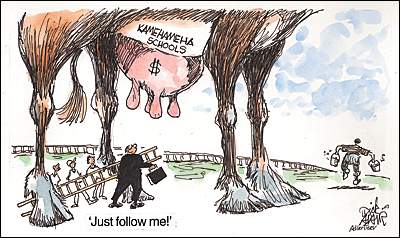
Cartoon by Corky in the Honolulu Star-Bulletin of May 24, 2007. Original URL for the cartoon was
http://starbulletin.com/2007/05/24/news/corky.html

http://www.honoluluadvertiser.com/apps/pbcs.dll/article?AID=/20070524/OPINION02/705240316/1108
Honolulu Advertiser, May 24, 2007
LETTERS TO EDITOR
LEGAL TACTICS
ATTORNEY'S SOLICITATION FOR CLIENTS UNETHICAL
I completely agree with David Shapiro's commentary (May 23) that described attorney David Rosen's solicitation for clients willing to file a new lawsuit against Kamehameha Schools. I find Rosen's appeal to be thoroughly disgusting and unethical.
Sadly, by offering a "no-cost" arrangement, Rosen is sure to dredge up his quota of 10 to 20 plaintiffs. And, once again, the school will have to put out hundreds of thousands of dollars to fight a frivolous lawsuit in the court system, draining funds that would otherwise be going to address the educational needs of innocent and deserving Hawaiian children.
I hope that every person, Hawaiian or not, who believes that the will of Princess Pauahi should be upheld will write a letter to Rosen expressing their disgust over his solicitation.
Nanette Naioma Napoleon
Kailua
BOYCOTT WOULD SEND LAWYER CLEAR MESSAGE
Attorney David Rosen's challenge to Kamehameha's entrance requirements is interesting in what it reveals about him personally and professionally.
Does he not have enough cases to keep himself busy? How did he become so empty that he believes he is entitled to what he is not? What do his actions say about his lack of character, that he can tie up monies that could otherwise educate Hawaiian children?
Does he seriously think his threat will go unchallenged?
Let us send a message he will hear, in his pocketbook: Boycott his business.
Pat Kamalani Hurley
Kamehameha Class of '73, Mililani
SHAMEFUL TACTICS WILL EMBARRASS LAW FIRM
Never in my life have I been more ashamed to walk down Bishop Street than at this moment, knowing that a firm like the Law Office of David B. Rosen is allowed to practice law in Hawai'i under the guise that it is ethical or moral or, dare I say it, even have a heart. Never.
I'm sure you will get countless letters that say the same, but let me make sure you hear it loud and clear: "Shame on them."
The law firm is fishing for the worst kinds of people: opportunists. And nothing will come of this but embarrassment for the law firm and shame for everyone involved.
I believe that people like Rosen are greatly underestimating the resiliency of the Hawaiian people and the steadfastness of Kamehameha Schools/Bishop Estate and its commitment to protect Pauahi's dream.
His foundation is greed and, as always, such a shallow foundation will inevitably crumble.
R. McDonald <br>
Honolulu
ATTORNEY'S CALL TO CASH IN UNFORGIVABLE
No one in their right mind can blame David Rosen for considering a new lawsuit against Kamehameha Schools. The KSBE trustees basically rolled out the red carpet to all such attorneys when they settled the John Doe case out of court.
What's unforgivable is Mr. Rosen's decision to issue an open invitation for others to cash in on this matter.
Young John Doe and his family chose to pursue their protest against KS's admissions policy because of their failed attempt to gain an invitation for enrollment.
Mr. Rosen, to his discredit, appears to be inviting non-Hawaiian students and their parents to help his "cause" (he says it's principle; everyone else knows it's about money) by applying for enrollment just so that they can get rejected by the school.
Shame on you, Mr. Rosen. There's no escaping this simple truth: What goes around will surely come around.
James Kauh
Makawao, Maui
http://www.honoluluadvertiser.com/apps/pbcs.dll/article?AID=/20070525/NEWS20/705250367/1170/NEWS
Honolulu Advertiser, Friday, May 25, 2007
Lawyer's e-mail under scrutiny
By Ken Kobayashi
Advertiser Courts Writer
The Hawai'i State Bar Association's board of directors is considering issuing a statement today that says lawyers play a key role in helping protect constitutional and civil rights, but whether a Honolulu attorney seeking to challenge Kamehameha Schools' Hawaiians-first admission policy violated any ethical rules should be left to the state agency in charge of overseeing lawyer misconduct.
The statement was suggested by board member Hugh Jones at the monthly board of directors meeting, which took up the issue of whether the board should issue a statement in view of the reaction to an e-mail sent by Honolulu attorney David Rosen that some say is damaging to the reputation of attorneys.
Several board members said Jones' proposal is a good start in fashioning a public statement, but at least one board member suggested the members should take more time before making any public pronouncement.
Bar association president Jeffrey Portnoy said he would be circulating among the board members Jones' proposal as well as one suggesting no statement be issued.
Rosen's e-mail said he was trying to put together a group of 10 to 20 plaintiffs for a lawsuit similar to the one by an unnamed non-Hawaiian teen-ager known only as John Doe who challenged the school's 120-year-old admissions policy.
The e-mail followed a settlement in which Kamehameha Schools paid an undisclosed amount of money to the teenager in exchange for the dismissal of the challenge as the U.S. Supreme Court was considering whether to rule in the case.
The e-mail eventually wound up with Kamehameha Schools supporters, who were outraged by the communication. And it raised enough of a reaction that Portnoy placed on the agenda a discussion about the reaction to the e-mail.
Rosen said the e-mail is not a violation of any ethical rules.
He said his motivation behind the e-mail is not to make money, but to "eliminate discrimination."
"This is about principle," he told the board members.
He said although a complaint apparently has been filed against him with the Office of Disciplinary Counsel, he's asked for a quick decision.
Some board members made clear that they did not want to get into the merits of whether the e-mail violated any rules, which, as reflected by Jones' suggestion, they felt is a matter for the disciplinary counsel.
But Portnoy said the matter involves a broader issue of the public's view of lawyers. He said if someone or a group believes the image of lawyers has been affected by the actions of a lawyer or group of lawyers, the board would be "remiss" in at least not considering the issue.
Portnoy said he wants to hear from members about proposed statements by noon today, but also indicated the board may decide to issue no statement at all.
At least two members of the board expressed concern about being involved in the matter because they do work for Kamehameha Schools, the state's largest private landowner. One formally declined to take part in any vote on a statement and the other also voiced concerns about participating.
Portnoy works for a law firm in which a partner does work for Kamehameha Schools, but Portnoy said after the meeting that he sees no conflict with him putting the issue on the board's agenda.
As president, he said, he has a responsibility to run the organization, and he had been asked by lawyers and nonlawyers, none of whom was associated with Kamehameha Schools, to address the matter which deals with the larger issue of the public's perception of the way lawyers get clients.
Portnoy said the alleged solicitation of clients for a suit against Kamehameha Schools may have triggered the issue, but indicated he would have done the same if it had involved another institution. He also said he doesn't vote on the matter.
Rosen said he thought the meeting involved a "fair discussion."
He said he believed Jones' suggestion was "completely appropriate."
----------------
12. Photos captured from recording of KGMB9 TV news broadcast June 8, 6 PM. The transcript of that news broadcast is provided in item #3 above, including the short speech given by Kamehameha CEO Dee Jay Mailer. These photos show the protesters in front of the building; the singing of "Kaulana Na Pua" led by Professor Jonathan Osorio (on right with guitar) with agitator/organizer Professor Lynette Cruz, (grey-haired lady on the far left with camera); and Kamehameha CEO Dee Jay Mailer (standing by vehicle and beginning to speak). The white van next to Mailer has a yellow stripe on the door saying "For Official Use" along with an oval-shaped seal, which could be either the Kamehameha Schools seal or else the seal of the State of Hawaii or the City of Honolulu.
Interestingly, some of the photos (both by KGMB in item #12 and by the protesters themselves in item #13) show that at least three kahili were present. A kahili is a bundle of feathers fastened onto a pole and held vertically. To modern Americans they look like brushes for cleaning chimneys, or overgrown feather-dusters. Today they are made from chicken or turkey feathers which are painted and glued. In ancient times they were made from the naturally-colored feathers plucked from native birds (catch and release, taking just 2-3 feathers from each bird); and the feathers were fastened by means of cordage woven from native plants. The presence of kahili in ancient times signified the presence of a high-ranking chief. So perhaps these ersatz (faux) modern kahili were brought to this protest to give honor to Dee Jay Mailer who, as CEO of the $8-15 Billion Kamehameha Schools, is indeed a ruling chief of a large empire. Despite her exceedingly light complexion, Mailer is a graduate of Kamehameha Schools and does have some (small) percentage of Hawaiian native blood.
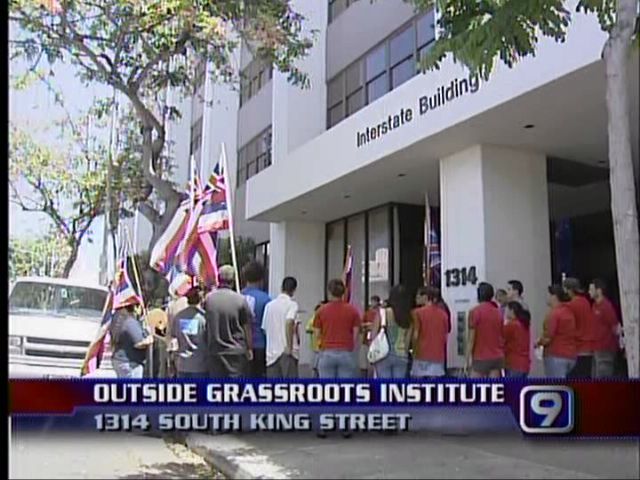
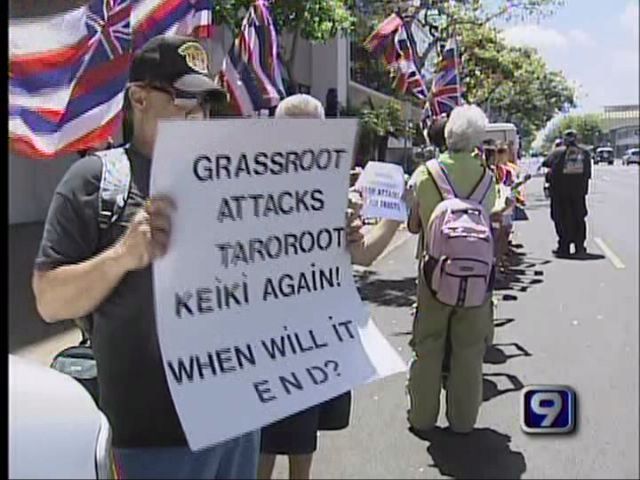
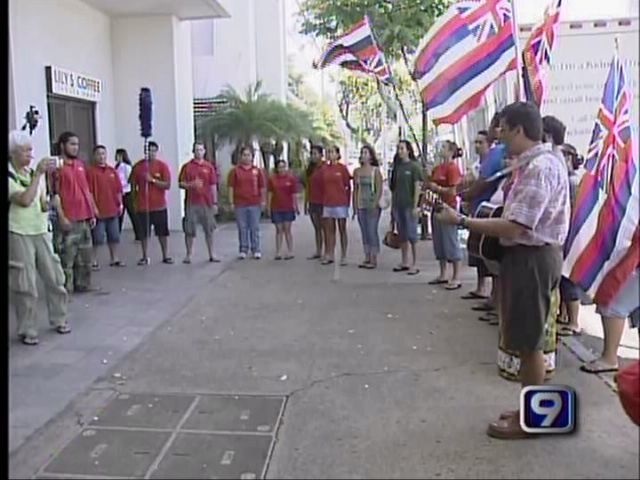

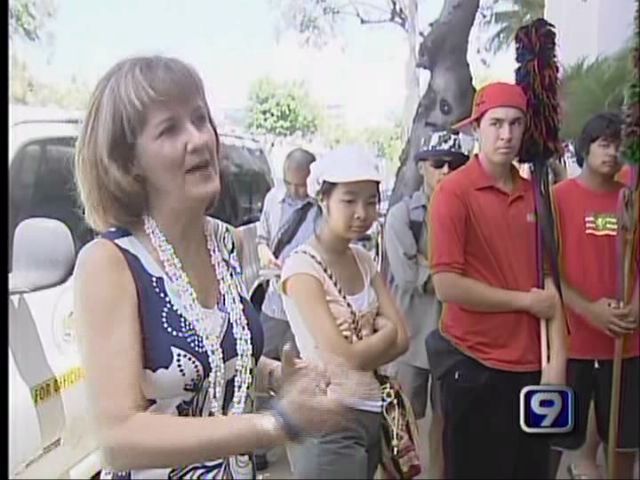
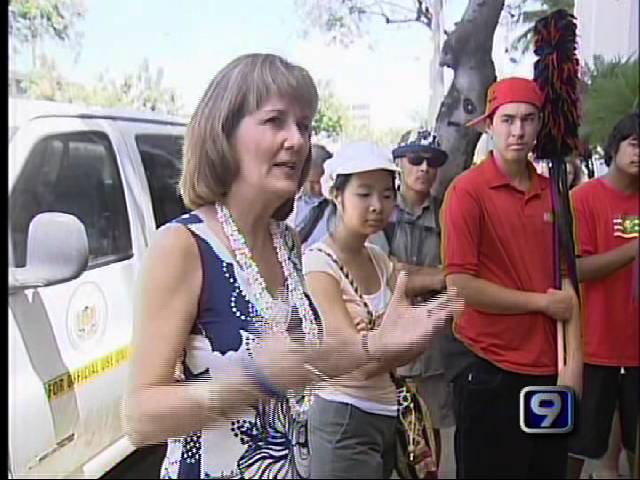
----------------
13. Photos taken by protesters to showcase their event of June 8, 2007 at the GRIH office. Street scenes show the typical strategy: kids and cute hotties in front, organizers and leg-breakers in back.
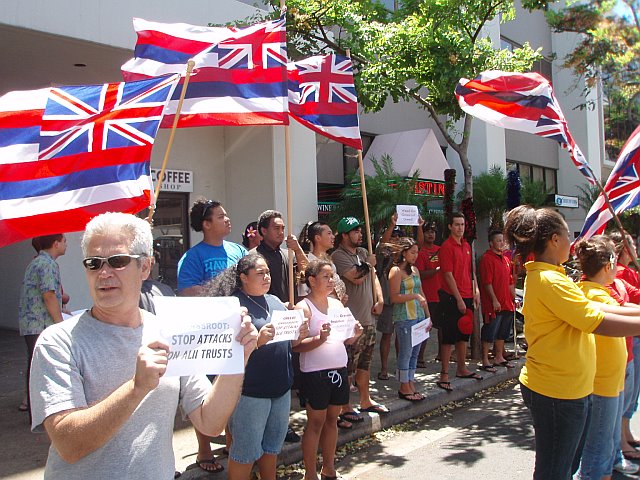
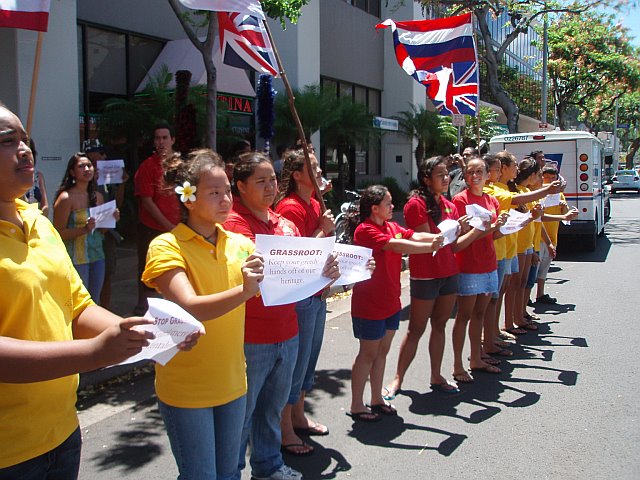
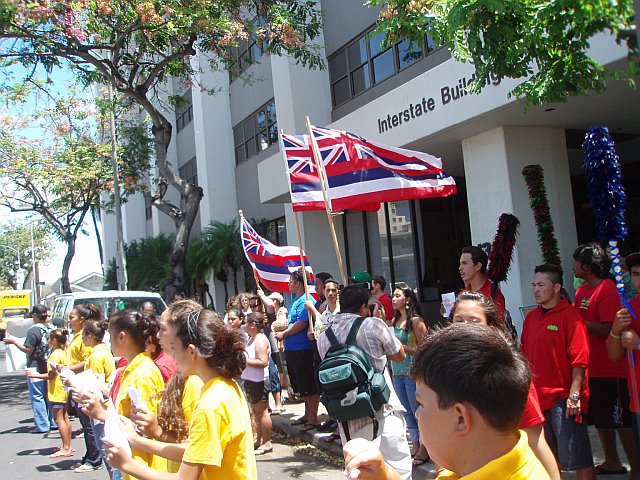
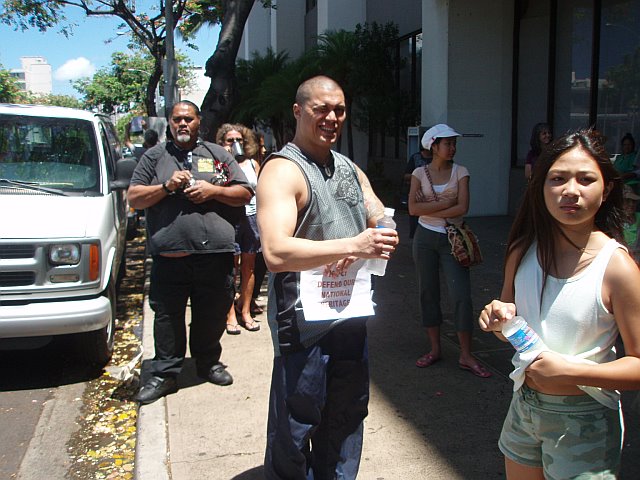
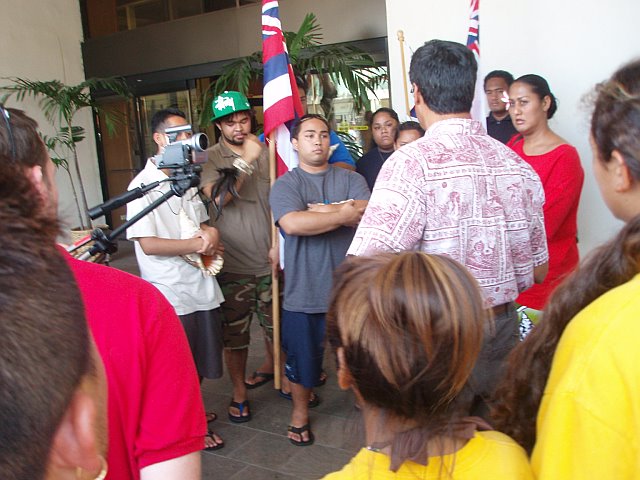
Professor Jon Osorio, Chairman of University of Hawaii Center for Hawaiian Studies, gives a pep-talk/lecture.